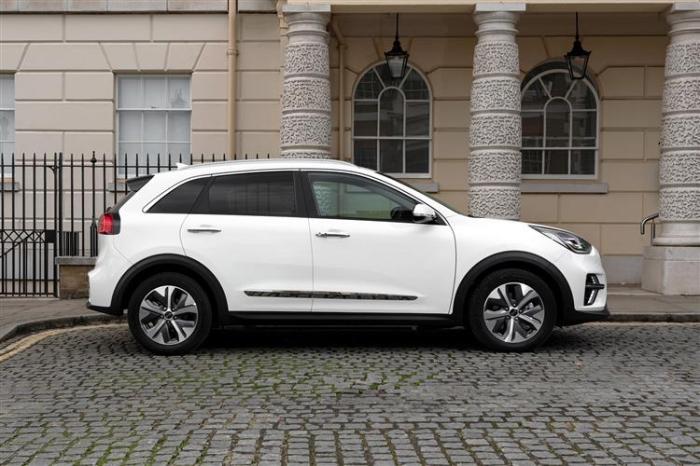kia leasing sets the stage for this enthralling narrative, offering readers a glimpse into a story that is rich in detail and brimming with originality from the outset. Leasing a Kia vehicle provides a unique opportunity to experience the latest technology and features without the commitment of ownership. This approach allows drivers to enjoy all the benefits of a new car while maintaining financial flexibility.
With various leasing options available, potential lessees can weigh the differences between leasing and buying, ultimately discovering the financial perks that leasing a Kia can offer.
Overview of Kia Leasing
Leasing a Kia vehicle offers an alternative to traditional car ownership, allowing individuals to drive a brand-new vehicle for a specified period without committing to a full purchase. This arrangement appeals to a broad audience, including those who prefer lower monthly payments and the flexibility of changing vehicles more frequently. Understanding the advantages of leasing compared to buying is crucial for making an informed decision regarding vehicle acquisition.Leasing involves a contractual agreement where the lessee pays for the use of a vehicle for a predetermined time, typically ranging from two to four years.
At the end of the lease term, the vehicle is returned to the leasing company. This differs fundamentally from buying, where the buyer owns the car outright and is responsible for its full purchase price, as well as depreciation and maintenance costs.
Comparison Between Leasing and Buying a Car
When deciding between leasing and buying a Kia vehicle, several key factors should be considered. The following points highlight the distinctions between the two options:
- Ownership: Leasing does not confer ownership of the vehicle; you merely have the right to use it for the term of the lease. In contrast, purchasing makes you the owner once the payment is complete.
- Monthly Payments: Lease payments are generally lower than loan payments for purchasing, making leasing more financially accessible in terms of upfront costs.
- Maintenance Costs: Leased vehicles are typically under warranty for the entire lease term, reducing maintenance expenses significantly. Owners bear the full cost of repairs once warranties expire.
- Depreciation: When leasing, you are not responsible for the vehicle’s depreciation, as this is borne by the leasing company. Buyers, however, face the risk of depreciation affecting their vehicle’s resale value.
- Flexibility: Leasing allows for the option to drive a new vehicle every few years, providing access to the latest technology and features. Ownership usually involves longer-term commitments to a single vehicle.
Financial Benefits of Leasing a Kia, Kia leasing
Leasing a Kia presents several financial advantages that can make it an appealing choice for many drivers. These benefits are crucial in evaluating the overall cost-effectiveness of leasing over purchasing.
- Lower Initial Costs: Lease agreements often require a lower down payment compared to purchasing, which can make the leasing option more accessible for budget-conscious individuals.
- Reduced Monthly Payments: Monthly lease payments tend to be lower than monthly financing payments for buying, freeing up more cash for other expenses or investments.
- Tax Advantages: In some regions, leasing may offer tax benefits, especially for business owners who can deduct lease payments as business expenses.
- Lower Overall Maintenance Costs: With new vehicles typically under warranty during the lease term, major repairs and maintenance are often covered, minimizing out-of-pocket expenses.
- Opportunity to Drive High-End Models: Leasing allows access to higher-end Kia models at a lower cost than if purchasing, enabling drivers to enjoy better features and technology.
“Leasing can be a financially savvy way to enjoy the latest automotive innovations without the long-term commitment of ownership.”
Kia Leasing Options

Kia leasing provides a flexible and affordable way for customers to drive home in a new vehicle without the long-term commitment of purchasing. With a variety of leasing plans, Kia caters to diverse customer needs, offering options that fit different budgets and preferences.Kia’s leasing options include several plans designed to accommodate varying financial situations and lifestyle needs. Each plan has distinct terms and conditions, catering to a wide array of customers, from those looking for a short-term solution to those seeking a longer commitment.
Understanding the nuances of these plans can help potential lessees make informed decisions.
Types of Kia Leasing Plans
Kia offers various leasing plans that differ based on vehicle models, lease duration, and mileage limits. Here are some key leasing options available:
- Standard Lease: This is the most common type, typically lasting between 24 to 36 months with annual mileage limits ranging from 10,000 to 15,000 miles. The standard lease is ideal for individuals who prefer driving newer models every few years.
- Short-Term Lease: Lasting less than 24 months, this option is perfect for those who may need a vehicle temporarily, such as while traveling or during a transitional period in their lives.
- Long-Term Lease: For customers wanting extended access to a Kia vehicle, longer leases can last up to 48 months or more. This plan usually offers lower monthly payments but may require higher mileage allowances.
- Specialty Leases: Kia sometimes offers specialty leases on specific models, designed to attract a niche market, such as electric vehicles or high-performance models, often including unique terms and promotional incentives.
Terms and Conditions of Kia Leases
Understanding the terms and conditions of Kia leases is essential for making the right choice. Key differences include mileage allowances, down payment requirements, and end-of-lease fees.
For instance, exceeding the mileage limit can incur significant penalties, often around 15 to 25 cents per additional mile.
Lease contracts also vary in terms of the required down payment. While some may require a substantial upfront payment to lower monthly costs, others might offer zero down payment options. Furthermore, at the end of the lease term, customers may face disposition fees if the vehicle is not purchased or if any excessive wear and tear is noted.
Kia’s Special Leasing Promotions
Kia frequently runs special leasing promotions, particularly for new model releases or during seasonal sales events. These promotions can significantly lower the cost of leasing a vehicle, making it an attractive option for potential customers.
- Low Monthly Payments: Kia often advertises leases with significantly reduced monthly payments for select models, allowing customers to drive a new vehicle without straining their budget.
- Deferred Payments: Some promotions may offer deferred payment options, where customers can start making payments after a set period, giving them immediate access to the vehicle without immediate financial pressure.
- Enhanced Mileage Packages: Special promotions may include increased mileage limits at no extra cost, addressing the needs of customers who drive more frequently.
- Trade-In Bonuses: Kia sometimes offers additional incentives or bonuses for customers who trade in their current vehicles as part of the leasing process, making it easier to upgrade.
Eligibility and Requirements
Leasing a Kia vehicle involves specific eligibility criteria and documentation that potential lessees must meet. Understanding these requirements is essential for a smooth leasing process and to ensure that you can secure the vehicle that best fits your needs.The typical eligibility criteria for leasing a Kia include factors such as age, income, and creditworthiness. Generally, you need to be at least 18 years old and have a steady income that demonstrates your ability to make monthly lease payments.
Additionally, a valid driver’s license and proof of insurance are necessary to proceed with the leasing process.
Typical Eligibility Criteria
Meeting specific criteria is crucial for leasing a Kia. Some common eligibility requirements include:
- Age Requirement: Most leasing companies require you to be at least 18 years old.
- Income Verification: A stable source of income, often verified through payslips or bank statements, is necessary to demonstrate financial capability.
- Residency Status: Proof of residency may be required, typically through utility bills or rental agreements.
- Driver’s License: A valid driver’s license is mandatory.
Necessary Documentation
Proper documentation is vital for the leasing process. Gathering the required documents in advance can expedite your application. The key documents needed typically include:
- Proof of Identity: A government-issued ID, such as a driver’s license or passport.
- Proof of Income: Recent pay stubs, tax returns, or bank statements to validate income.
- Proof of Residency: Utility bills or lease agreements that confirm your current address.
- Credit History: Some leasing companies may require a credit report, which reflects your creditworthiness.
Credit Score Considerations
Your credit score plays a significant role in determining your eligibility for leasing a Kia. A higher credit score often results in more favorable lease terms, such as lower monthly payments and reduced down payments. Conversely, a lower credit score may lead to higher interest rates or even denial of the lease application. Typically, a credit score of 680 or higher is considered favorable for leasing.
For those in search of a larger vehicle, the SUV BMW X7 offers a remarkable blend of performance and luxury. This three-row SUV is designed to accommodate families while delivering a powerful driving experience, thanks to its robust engine options. With premium materials and the latest infotainment technology, the X7 ensures that every journey is enjoyable and stylish.
Factors affecting your credit score include:
- Payment History: Timely payment of previous debts can positively influence your score.
- Credit Utilization: Keeping your credit card balances low relative to your credit limits can enhance your score.
- Length of Credit History: A longer credit history may be beneficial, as it allows lenders to assess your repayment behavior.
“A higher credit score not only increases your chances of lease approval but also opens doors to better leasing conditions.”
The Volvo XC60 stands out in the luxury compact SUV market, combining Scandinavian design with advanced safety features. With its spacious interior and cutting-edge technology, it’s a perfect choice for those who prioritize comfort and style. Whether navigating city streets or embarking on a weekend getaway, this SUV promises a smooth and enjoyable driving experience.
Understanding Lease Terms

The lease agreement is a pivotal document that Artikels the specifics of your Kia leasing experience. Understanding its components is crucial for making informed decisions and ensuring smooth ownership during the lease term. This section delves into the essential elements of a Kia lease agreement, explains the significance of mileage limits, and provides insights on lease-end options and responsibilities.
Key Components of a Kia Lease Agreement
A Kia lease agreement consists of several critical components that dictate the terms of the leasing arrangement. Understanding these elements helps you manage your expectations and responsibilities effectively. The main components include:
- Monthly Payment: This is the amount you will pay each month, calculated based on the vehicle’s depreciation, interest rates, and any additional fees.
- Lease Duration: Typically ranging from 24 to 48 months, this is the agreed period during which you will lease the vehicle.
- Residual Value: This is the estimated value of the car at the end of the lease term, which plays a significant role in determining your monthly payments.
- Capitalized Cost: This is the price of the vehicle minus any down payment or trade-in value, essentially what you are financing through the lease.
- Interest Rate: Often expressed as a money factor, this influences your monthly payments based on the lease’s financing cost.
Mileage Limits in Leasing
Mileage limits are a fundamental aspect of leasing a Kia vehicle. Exceeding these limits can result in hefty penalties at the lease’s conclusion, making it essential to understand how they work. Most leases will specify an annual mileage limit, typically set at 10,000 to 15,000 miles per year. The significance of adhering to these mileage limits is underscored by the following points:
- Costs of Exceeding Limits: If you go over the agreed mileage, you’ll incur additional fees, which can range from 15 to 25 cents per mile, depending on your lease terms. This can add up quickly, leading to unexpected expenses.
- Vehicle Depreciation: Higher mileage typically equates to increased wear and tear, which can lower the vehicle’s residual value and affect your lease-end options.
- Choosing the Right Mileage Plan: When signing your lease, it’s crucial to assess your driving habits. If you anticipate driving more than the mileage limit, you may want to negotiate a higher mileage allowance upfront to avoid penalties.
Lease-End Options and Responsibilities
As your lease term comes to an end, you will have specific options and responsibilities to consider. Being informed about these choices can facilitate a smoother transition, whether you decide to purchase the vehicle or return it. Key lease-end options include:
- Purchase Option: At the end of the lease, you often have the opportunity to buy the vehicle at its residual value. This is ideal if you’ve enjoyed your Kia and want to continue driving it.
- Return Option: You can return the vehicle to the dealership, but be prepared for any potential charges that may apply for excess wear and tear or mileage overages.
- Trade-In Option: Some leasing companies allow you to trade in the leased vehicle for a new lease, which can provide a convenient way to upgrade your Kia.
Understanding your responsibilities at lease-end is equally important. You will need to ensure that the vehicle is in good condition, adhering to the agreed-upon standards, and that you are aware of any charges that may apply based on the lease agreement terms.
Being proactive and informed about your lease terms can lead to a more satisfying and financially sound leasing experience.
Maintenance and Care During the Lease

Maintaining your leased Kia vehicle is essential for ensuring its longevity and performance. Proper care not only enhances your driving experience but also helps in avoiding penalties related to excessive wear and tear when the lease term ends. Understanding the maintenance requirements and adhering to them is crucial for any lessee.Regular maintenance helps in keeping the vehicle running efficiently and ensures that it remains in good condition.
Here are some essential maintenance tips to consider during your lease:
Maintenance Tips for Leased Kia Vehicles
To preserve the value of your leased Kia, it is imperative to follow a structured maintenance routine. Below are critical tips that can assist you in keeping your vehicle in top shape:
- Regular Oil Changes: Check the owner’s manual for recommended oil change intervals and adhere to them. Regular oil changes ensure optimal engine performance.
- Tire Maintenance: Rotate tires every 5,000 to 7,500 miles, and ensure they are properly inflated to enhance fuel efficiency and prolong tire life.
- Brake Inspection: Have brakes inspected regularly. If you notice any unusual squeaking or longer stopping distances, get them checked immediately.
- Fluid Checks: Regularly inspect brake, transmission, and coolant fluids. Top off or replace these fluids as necessary to prevent any mechanical failures.
- Battery Care: Monitor the battery condition and clean any corrosion around terminals to maintain optimal performance.
Handling Wear and Tear on a Leased Vehicle
Understanding how to manage wear and tear on your leased Kia is pivotal in avoiding additional charges at the end of your lease. It is vital to differentiate between normal wear and excessive damage. Below are guidelines to help mitigate potential issues:
- Document Condition: Take photos of the vehicle’s condition at the start and throughout the lease. This documentation can protect you against unfair wear and tear assessments.
- Repair Minor Damage: Address minor dents, scratches, or any interior damage promptly to prevent escalation and costlier repairs later.
- Keep it Clean: Regularly wash and detail the vehicle to keep the interior and exterior looking fresh, preventing long-term damage from dirt and grime.
- Avoid Modifications: Stick to factory settings and avoid aftermarket modifications that can lead to additional charges when returning the vehicle.
Importance of Keeping Service Records During the Lease Term
Maintaining detailed service records throughout your lease can play a significant role in your leasing experience. Keeping track of all maintenance and repairs offers several advantages:
- Proof of Maintenance: Service records serve as proof that the vehicle has been well-maintained, which can be beneficial during the lease-end inspection.
- Warranty Compliance: Adhering to the maintenance schedule ensures compliance with warranty terms, safeguarding you against unexpected repairs.
- Better Resale Value: Well-documented service history can enhance the resale or trade-in value of the vehicle if you decide to lease another Kia.
- Transparency: Having organized records fosters transparency with the leasing company, making potential disputes easier to resolve.
“A well-maintained vehicle not only enhances driving pleasure but also protects you from unexpected costs at the end of your lease.”